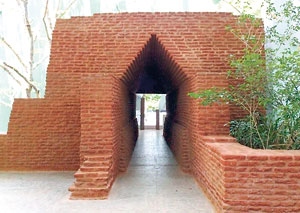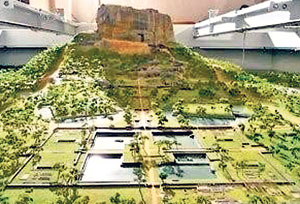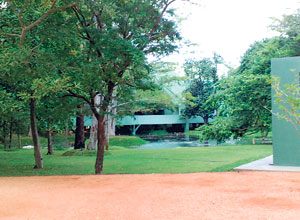Sigiriya has been a popular place to visit for both the young and the old. Apart from the marvel of the 5th century rock fortress, the glorious paintings, the writings on the Mirror Wall and the beautiful gardens on top of the rock, now there is something new for the visitor to see. That is the recently opened Sigiriya Museum – a marvel in itself.
 |
| The entrance to the Museum. |
 |
| Model of Sigiriya. |
 |
| The museum surrounded by water. |
Managed by the Central Cultural Fund, the Museum can be described as 'a three-in-one' operation. Primarily an
archaeological site museum, it is also a visitor information centre and a research facility. It brings into focus the results of decades of archaeological research at Sigiriya and the
surroundings extending up to Dambulla. One can get a clear
understanding of the history of Sigiriya from prehistoric times to the present day.
Sigiriya Museum is located in the huge garden opposite the main entrance to the fortress – to the west of the outer moat and the outer
ramparts. Once you enter the
garden you go through the Osu Uyana, the botanical garden
established in the early 1990s.
As you walk a little distance, on the left is a building merged with the forest. It houses the museum. Huge ponds full of water and flowering plants adorn the vicinity.
You walk into the museum and you are invited to watch an
audio-visual presentation describing the history of Sigiriya. You can watch any of the three versions – English, Sinhala or Tamil. You come out and face a brick arch through which you enter the exhibit area.
In Exhibition Gallery 1 you are taken on a quick visit through time from the geological past to the
present. The display covers 12
thematic and chronological divisions.
These include pre-history and
proto-history, iron production, early Buddhist monasteries, the 'golden age' of Sigiriya, the terracotta
sculpture, the paintings, the graffiti poems, and the history of archaeology at Sigiriya.
The exhibits are a varied lot,
ranging from artifacts to maps, plans, models, photographs, film and audio recordings. These cover six
galleries and the visitor can get all the related information though the text presented near each display. A large amount of artifacts collected over many decades give the visitor a clear idea of the rich heritage of which we can be proud of.
Among the specialties are the stone tomb from the Ibbankatuwa cemetery, an actual iron smelting furnace from Alakolawewa, stone tools used as early as 4000 BC, Buddha images belonging to different periods, and the gild bronze ear-ring of which you can get a closer look through a magnifying glass and see the
intricacies.
(Cameras being taboo photographs cannot be taken of these exhibits.)
At one point you stop to listen to a voice recording. It's a poem
written in the Mirror Wall referred to as 'kurutu gee' – one of the 685
creations by unknown travellers
dating back to anytime between the 6th and 13th centuries.
A scale model of the Sigiriya rock and the gardens under a glass floor is simply amazing. You can walk on the glass (one feels one should not do so) and stand around a railing,
contemplating the mighty work of King Kassapa in re-creating the 'Alakamanda' – the abode of Kuvera, the God of Wealth.
You come out of the exhibit area having absorbed the finer elements of a glorious past and land near a
spiral staircase – a replica of the one you go up to see the beautiful
frescoes. You climb it and reach the recreated fresco galleries with the Sigiriya paintings copied by Sri Lankan artists. The accurate replicas of the fresco galleries have been done in Japan, which incidentally financed the entire project.
As you wind your way towards the exit, you pass through several stalls selling arty objects and souvenirs and a bookstall.
While those who are unable to climb Sigiriya can now enjoy all its splendour with a visit to the museum, even those who do, can get a better insight into this unique World Heritage Site.
Yet to finish
Though much of the Museum is complete, there is more to be done. By June 2010 it will be completed and until then admission is free.
The Museum is open on all days, except Wednesdays, from 8 in the morning until 5 in the evening. |



